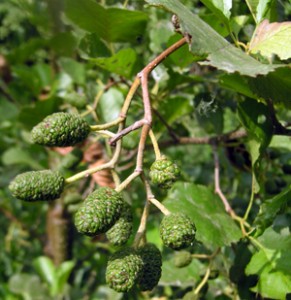Iceland’s missing woodland and forest.

Some ten to fifteen million years ago, Iceland supported forests and woodlands of Redwoods (Sequoia), Magnolia and Sassafras. The presence of such species suggests that at this time the climate was warm and temperate. Later, in the Pliocene period, evidence from pollen studies, suggest that Pines, Larch, Birch and Alder had come to dominate; species that are associated with Boreal Forest - so the climate had cooled considerably.
There then followed the glaciations of the Pleistocene (often simply referred to as the Ice Age) - a geological epoch which lasted from about 2,500,000 to 12,000 years ago. Glaciers marched across the surface of the Earth, but retreated in the warmer inter-glacial periods.
With these successive glaciations, the Icelandic flora became increasingly species poor. The Pines and Alders probably survived for some time but the only woodland / forest species to re-establish in the present inter-glacial period is downy birch (Betula pubescens). Rowan and Aspen can also be found, together with a willow - the latter usually grows as a shrub.
When Iceland was settled about 1150 years ago, a significant proportion (perhaps up to 40%) of the land was covered with downy birch woodland and forest. The birch could reach heights of 15 metres or so in more sheltered inland areas, but in exposed and coastal areas it grew largely as scrub (as did the willow).
 The settlers needed to build and to keep warm - so the birches provided timber and fuel; and in cutting down the trees, land was opened up for the grazing of sheep (which, in turn, provided wool and meat). The grazing of the sheep prevented the regeneration of the (cut / harvested) birchwood, so that slowly but surely birch woodland and forest declined. The timber from the woodlands also provided another vital commodity - charcoal. This was used to smelt iron and make iron tools. In consequence by the middle of the C20th, woodland and forest cover was less than 0.5% of Iceland's area.
The settlers needed to build and to keep warm - so the birches provided timber and fuel; and in cutting down the trees, land was opened up for the grazing of sheep (which, in turn, provided wool and meat). The grazing of the sheep prevented the regeneration of the (cut / harvested) birchwood, so that slowly but surely birch woodland and forest declined. The timber from the woodlands also provided another vital commodity - charcoal. This was used to smelt iron and make iron tools. In consequence by the middle of the C20th, woodland and forest cover was less than 0.5% of Iceland's area.
A Forestry Service was established in 1908. It has promoted the planting of millions of downy birch seedlings, particularly in areas where there are remnant forest / woodland remains (this is coupled with enclosure of areas to exclude sheep).  In addition, various species of larch and sitka spruce have also been planted. Sadly, the funding for forestry has declined since Iceland experienced a financial crisis in 2008/9; but the Forestry Service(s) now manage some 7000 hectares of woodland and forest , consisting of native birch woodland, plus some cultivated forests of coniferous trees and arboreta. The percentage cover by woodland and forest in Iceland is increasing - it now stands at approximately 1.5% of surface area.
In addition, various species of larch and sitka spruce have also been planted. Sadly, the funding for forestry has declined since Iceland experienced a financial crisis in 2008/9; but the Forestry Service(s) now manage some 7000 hectares of woodland and forest , consisting of native birch woodland, plus some cultivated forests of coniferous trees and arboreta. The percentage cover by woodland and forest in Iceland is increasing - it now stands at approximately 1.5% of surface area.
For more information on Iceland and its trees see :
Comments are closed for this post.
Discussion
I think it’s very interesting to read that you also provide information on the forests of countries other than in the UK. I hope that Iceland eventually is able to re-forest a greater area than 1.5% of its surface.

Just stumbled across this post. It’s shocking to learn that, even today, so little woodland area’s have survived / been replanted in Iceland.
I thought the UK woodland % surface area was bad!
Ryan
15 January, 2022